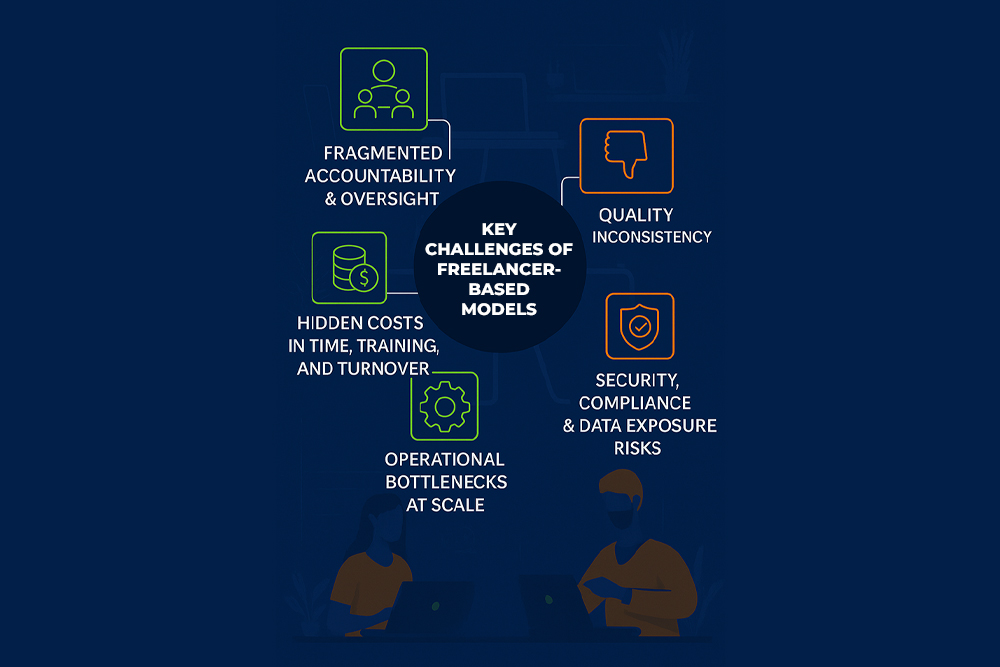Once considered a tactical advantage, freelancer-based models have quietly evolved into a foundational element for many modern businesses. Their appeal is clear: specialized skills on demand, minimal overhead, and rapid deployment. However, as organizations scale, the limitations of this fragmented workforce approach begin to surface.
The growing adoption of freelance platforms highlights a broader shift toward flexible talent models — but it also exposes critical operational risks. Businesses face challenges around quality control, data security, and maintaining alignment across a dispersed and transient workforce.
This is the first blog in our Rethinking Freelancers series, where we examine the strategic limitations of freelancer-based models. Stay tuned for our next piece: “Why Freelancers Don’t Scale for Midmarket Growth.”
The Freelance Model’s Breaking Points

1. Fragmented Accountability & Oversight
Freelancers work independently, often outside of structured systems. This makes it difficult to enforce SLAs, track progress, or ensure alignment across distributed contributors — especially in fast-scaling environments.
2. Quality Inconsistency
Without immersion in your brand or access to internal feedback loops, freelancers often deliver work that lacks consistency. This can impact the whole system and dilute the overall brand voice.
3. Security, Compliance & Data Exposure Risks
Freelancer setups typically lack enterprise-level security. In regulated industries, this poses serious compliance risks. GDPR violations, for example, can cost up to $23M or 4% of annual revenue.1
4. Operational Bottlenecks at Scale
Freelancers may handle isolated tasks well, but they aren’t designed for coordinated scale. As complexity grows, the lack of shared tools and structured processes leads to delivery delays and inefficiencies.
5. Hidden Costs in Time, Training, and Turnover
High freelancer turnover means constant onboarding. Add in lost time for oversight, and the perceived savings quickly disappear — draining focus from core business priorities.
Where the Market Is Headed — and What It Demands
A Gallup report indicates that 52% of remote-capable employees in the U.S. are working in hybrid arrangement as of February 2025.2
As the global workforce model evolves, so do the expectations placed on business infrastructure. Hybrid teams are now the norm, not the exception. Customer engagement is no longer limited to business hours or single channels. And with heightened scrutiny around data governance, organizations must ensure compliance is built into their delivery models — not outsourced as an afterthought.
For companies scaling into new markets or modernizing their operations, loosely connected freelance talent can’t support enterprise-grade consistency or strategic control. Instead, operational alignment is needed — teams that are embedded, accountable, and engineered to grow with the business.
A Better Alternative to Freelancer-Driven Models
As the freelance model shows its limitations, forward-looking organizations are embracing a more evolved approach — one that balances flexibility with structure and scale with accountability.
Co-sourcing and strategic partnerships are redefining what modern outsourcing can look like. These models embed external teams into your operations, align them with your culture and goals, and ensure continuity, compliance, and performance at every stage. Unlike fragmented freelance engagements, they offer an integrated extension of your business — built for consistency, resilience, and growth.
How Premier NX Fits into Your Growth Strategy

The shift away from fragmented, freelance-heavy models isn’t just a tactical move — it’s a strategic realignment. Premier enables that shift through a co-sourcing approach designed for continuity, control, and growth. Our teams don’t just plug in; they integrate, operate, and elevate your brand from within.
Here’s how we help businesses build for scale, resilience, and results:
- Co-Sourcing Model: Premier provides dedicated, culturally aligned resources that integrate with your team to support both back-office and customer-facing functions.
- Premier Sync Framework: At Premier, we approach our client relationships with a partnership mentality that allows us to tackle the entire recruiting and onboarding process while working together on business goals.
- Global Delivery Locations: With delivery centers in the U.S., Canada, China, Pakistan, and Philippines, we offer global coverage, multilingual support, and operational continuity.
- Five-Pillar Service Framework: We deliver across five strategic areas: Customer Experience, Digital Transformation, FinOps, Analytics, and Sales Enablement.
- Enterprise-Grade Compliance & Security: Built-in infrastructure and governance that meets the demands of regulated, customer-facing environments.
What’s Next
If your business is ready to move beyond fragmented talent models and build a workforce strategy designed for scale, security, and sustained growth — Premier is here to help.
Contact Premier NX to explore how our co-sourcing solutions can align with your goals.

